Alcocks History

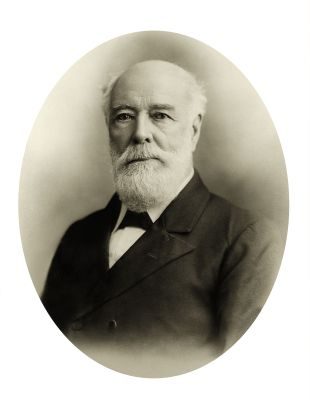
The rise to prominence of billiards in 19th century Australian life has been widely acknowledged as due significantly to one man: Henry Upton Alcock. The World of Billiards magazine1 referred to him as “The father of the Australian Billiards Trade”. Keith Dunstan, in his book, Sports2 and Andrew Ricketts, Walter Lindrum: Billiards Phenomenon3 agreed.
Billiards was being played in Melbourne before Alcock arrived in 1853. It is said that the first table for public use in Victoria was located in The Angel lnn, corner of Queen and Collins Streets, Melbourne, as early as 1838. But Alcock’s influence managed to make the game so popular that by 1877 he was able to write of billiards: “Today the favourite diversion of every gentleman of social influence or educated taste”.4
Henry Upton Alcock was born in Dublin on November 17th 1822. He set sail for Port Phillip in the Colony of Victoria, in October 1852 on the ship Africa. He arrived in Melbourne in April 1853, and set up in business in Fitzroy (we understand at the corner of Johnston and Gertrude Streets, Fitzroy5) with four workmen. By mid-December 1854 his sales were averaging a little over five pounds per day.6 Alcock managed to gradually build this tiny enterprise until it became one of Melbourne’s most substantial businesses in the latter period of the 19th century, with branches in Sydney, Adelaide, Brisbane, Perth and Wellington, New Zealand, and an agency in Tasmania. And he developed a reputation for the quality of Alcock billiard tables throughout the English speaking world.
Alcock approached billiard table manufacture with two aims in mind:
- To make a really excellent table; and
- To use local materials and products wherever possible.
Alcock saw the value and beauty of Australian timbers: Blackwood, Mountain Ash, Oak, Maple, Tulip Wood etc, at a time when most people thought that high quality furniture could only be constructed out of the traditional Walnut or Mahogany from Europe.
In the earlier years, Alcock had great difficulty in obtaining slate for tables. He found that some of the earlier settlers in Collingwood had built houses made entirely of slate. So he bought the houses, pulled them down and used the slate for his tables. Later, he was to own a slate quarry at Castlemaine, but to keep up the necessary volume he needed to import slate from Wales, Italy, and Portugal.7

ex Australasian Sketcher, 1881
By 1860, Alcock had moved to 132 Russell Street in the City of Melbourne (on the east side, between Little Bourke and Lonsdale Streets) and set up his manufactory there. By 1862 he was employing over 40 men and had installed quite extensive machinery.8 During 1867-68 he installed a new veneer saw, weighing three tons, diameter 12ft, cutting veneers as narrow as 14 to the inch. This machine took approximately six months to install, cost approximately £1,800, and was the only one of its kind then in the Southern Hemisphere.9 Using this saw, Alcock was able to supply veneer for the furniture trade throughout the Colony.10 By 1873 Alcock employed 60 men; by 1877 the establishment was capable of producing tables at the rate of one every four hours; by 1883 there were 140 on the payroll. Between 1883 and 1885 the Company put 4.5 million feet of logs through their breaking down saws.
Alcocks carried out virtually all of the processes of billiard table making under the one roof at Russell Street. Timber was brought in as logs, milled and seasoned. Table frames were built, legs turned, slates cut to size, dowelled, bolted and finished. Here the cushions were made, billiard balls turned out of ivory squares, cues and other accessories were made, and so on. For some years billiard cloth was the only imported item. Henry Alcock offered a prize of £500 for the first Australian manufacturer to produce a genuine high quality billiard cloth. That prize was never collected.

Alcocks became famous

In 1864, the then current “Champion Billiards Player of the World”, John Roberts, arrived in Melbourne. He was reported to have said of the Alcock table used during matches at the Albion Hotel: “l never played on a better table in my life”.11 Later, having toured the Colonies of Australasia, Roberts returned to London, taking an Alcock table with him for his billiard room. That table became a prototype for the “John Roberts Pattern” table, some of which are still being used today, such as the table in Government House, Victoria.
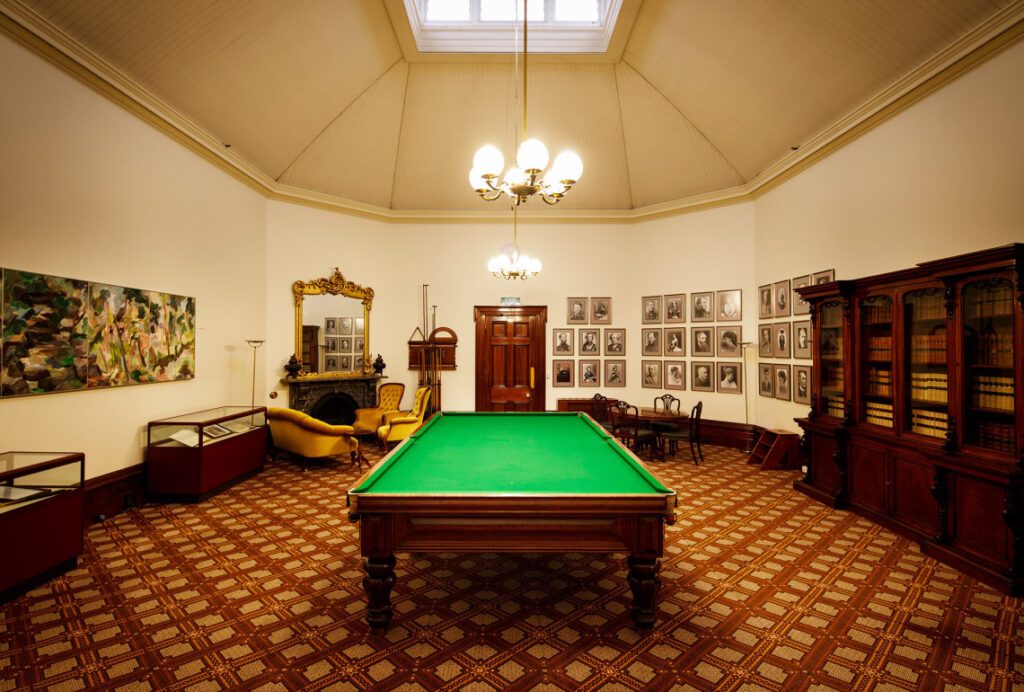
This magnificent billiard room, with superb vaulted ceiling, includes a gallery of portraits featuring each of the governors of Victoria.

In 1867 during the visit to the Colonies of Prince Alfred, Duke of Edinburgh (second son of Queen Victoria), Alcocks was commissioned by the Government of Victoria to prepare a table as a gift, since the Duke was fond of billiards.12 This event was reported in The Argus newspaper…
“THE ARGUS”
WEDNESDAY, OCTOBER 2, 1867
From the report in The Argus of the sitting of the Legislative Assembly, Melbourne, Tuesday, October, 1, 1867, page 5, concerning a billiard table to the order of the Government of Victoria, for the Duke of Edinburgh.
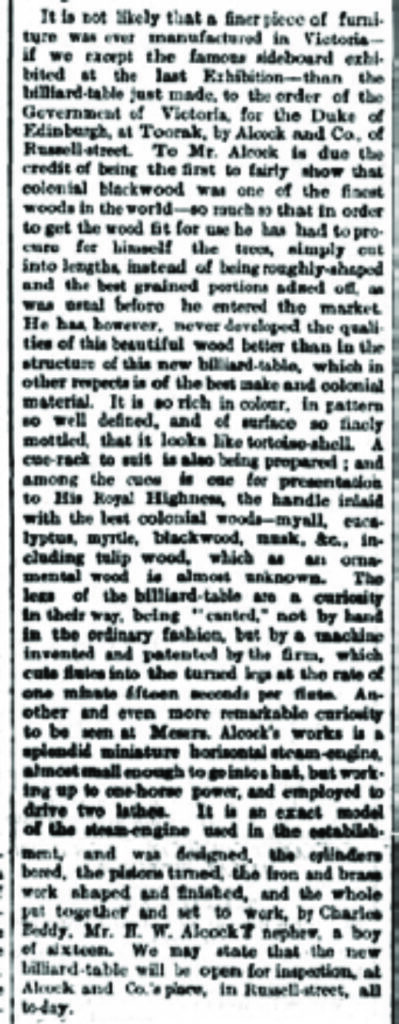
It is not likely that a finer piece of furniture was ever manufactured in Victoria if we except the famous sideboard exhibited at the last Exhibition-than the billiard- table just made, to the order of the Government of Victoria, for the Duke of Edinburgh, at Toorak, by Alcock and Co., of Russell-street. To Mr. Alcock is due the credit of being the first to fairly show that colonial blackwood was one of the finest woods in the world-so much so that in order to get the wood fit for use he has had to procure for himself the trees, simply cut into lengths, instead of being roughly- shaped and the best grained portions adzed off, as was usual before he entered the market. He has, however, never developed the qualities of this beautiful wood better than in the structure of this new billiard-table, which in other respects is of the best make and colonial material. It is so rich in colour, in pattern so well defined, and of surface so finely mottled, that it looks, like tortoise-shell. A cue-rack to suit is also being prepared; and among the cues is one for presentation to His Royal Highness, the handle inlaid with the best colonial woods-myall, eucalyptus, myrtle, blackwood, musk, &c, including tulip wood, which as an ornamental mental wood is almost unknown. The legs of the billiard-table are a curiosity in their way, being “canted,” not by hand in the ordinary fashion, but by a machine invented and patented by the firm, which cuts flutes into the turned legs at the rate of one minute fifteen seconds per flute. Another and even more remarkable curiosity to be seen at Messrs. Alcock’s works is the splendid miniature horizontal steam-engine, almost small enough to go in to a hat, but working up to one-horse power, and employed to drive two lathes. It is an exact model of the steam- engine used in the establishment and was designed, the cylinders bored, the pistons turned, the iron and brasswork shaped and finished, and the whole put together and set to work by Charles Beddy, Mr. H. W. Alcock’s nephew, a boy of sixteen. We may state that the new billiard-table will be open for inspection at Alcock and Co.’s place, in Russell-street, all today.
Alcocks developed a distinctive table which became the prototype of the famous “Duke of Edinburgh” model table, some of which today still remain the prized possession of a fortunate few billiards enthusiasts, such as the mansion Werribee Park.
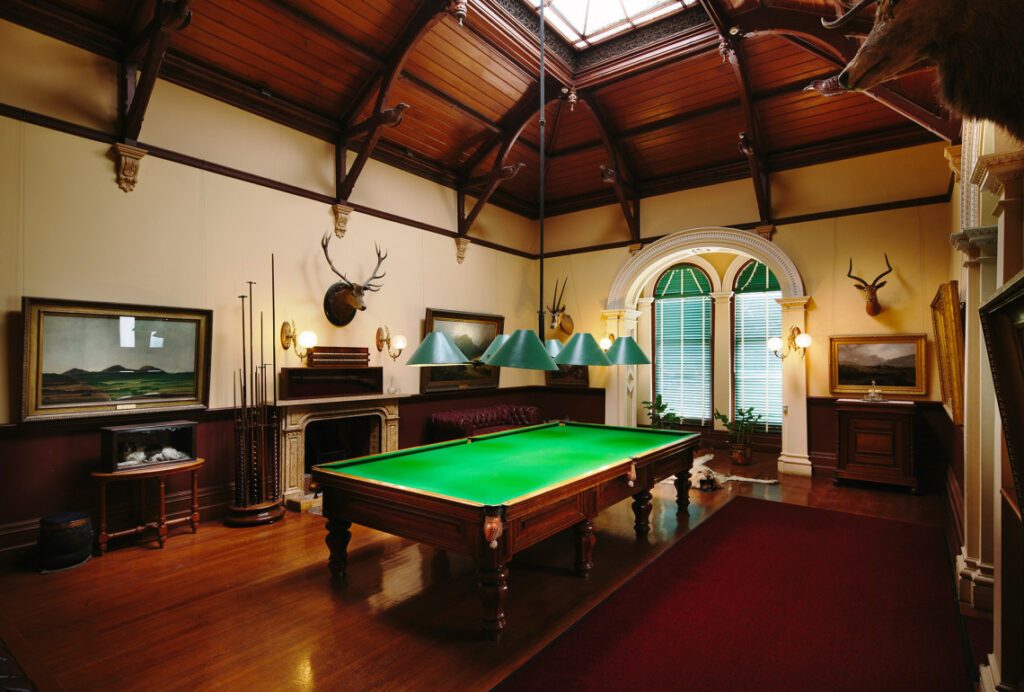
The mansion, built by the Chirnside brothers, includes a truly outstanding Australian billiard room, with an atmosphere very much in accord with the great traditional Clubs of the period.
Manufacturing Exhibitions
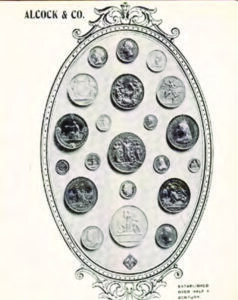
During the 19th century, manufacturing exhibitions became a regular feature of commercial life. Alcocks entered tables in quite a number of them, regularly winning prizes. By 1908 the Company held 27 medals gained as prizes from such exhibitions.
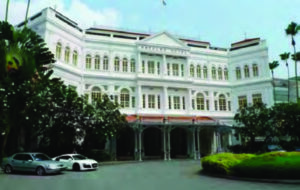
Alcock tables were purchased by many prominent clients, both private and institutional.They were (and still are) at Victorian Government House and one belongs to The Victorian Parliament. They are at the Melbourne Club, Australian Club, Melbourne, the Athenaeum Club, Melbourne Savage Club,Tattersall’s Club, Sydney, Australian Club, Sydney, and many others. Alcock tables were also in most of the prominent Melbourne hotels of the day including the Prince of Wales, Scotts, Menzies, the Bull and Mouth, etc. Many of the hotels in Victoria’s major country towns had one or more Alcock tables, as did clubs and hotels in New South Wales, South Australia, Tasmania, Western Australia, and New Zealand. Some tables were also exported to London, Japan, New Caledonia, Singapore,East Indies, Fiji, and Hawaii.
Important visitors
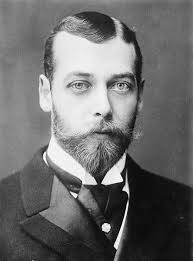
Important visitors to Melbourne such as the Duke of Edinburgh and later Prince George, Duke of York (subsequently King George V of England) and his brother, visited the Alcock Manufactory as part of their tour of the City.13 1n 1883 the Royal Commission on the Tariff visited the premises on a fact-finding tour (Alcock was very much against tariffs charged between the Colonies) and in July 1885 the Victorian Governor, Sir Henry Loch, KCB, paid an official Vice Regal visit as part of his effort to promote Victorian industry.14
But one of Henry Alcock’s major achievements was to encourage enthusiasm for the game of billiards. Alcock called it “the noble game” and referred to it as modern, scientific, civilized, and recommended it for health and relaxation etc. He also arranged, promoted and/or assisted the organisation of many billiards tournaments and championships.

For example, he brought John Roberts Jnr, then world champion, to Australia three times to meet up with local champions, as well as other players who were then famous but whose names mean little today. In 1884 he arranged a match to determine the Billiards Champion of Australia, providing a full-size billiard table as the winner’s prize. (This Championship was won by Englishman, H. Evans.) Again, in 1897, he provided assistance with a match to decide “the Spot Barred” Champion of Australia. In the earlier part of the 20th century, Alcocks set-up match rooms specifically for tournament play, first in their new Elizabeth Street Showrooms in the City, and later at Sturt Street, South Melbourne. This not only provided a venue for important matches but also assisted with the emerging local pennant game.
Henry Upton Alcock dies
In August 1912, Henry Upton Alcock died. He was nearly 90. During his lifetime he had produced several thousand billiard tables of extremely high quality, had written a book on billiards running to five Editions and played a major role in the development of the game of billiards in Australia. He did not play the game himself.
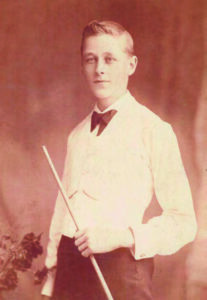
By the time of Alcock’s death, the stage had been well set: excellent playing conditions, a healthy and developing amateur competition, the stimulation of seeing the world’s best players, and a strong interest in the game on the part of the general community. This was the natural seedbed for producing Australian champions. They had already begun to emerge. A young George Gray came to the fore about 1906 and toured England quite successfully in 1911-12. In 1910-11 Fred Lindrum Jnr, beat John Roberts Jnr and Tom Reece, though Lindrum failed in a later English Tour.
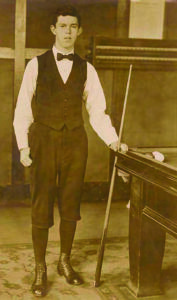
And by the year of Alcock’s death, Walter Lindrum had made breaks of 504 in practice and 312 during match play. He was 14 at the time and destined to be the greatest billiards champion in history. The rise of Australian billiards was complete.
Following Henry Alcock’s death, control of the business passed into the hands of his sons. Frederick Arthur Alcock became Managing Director and remained in this position until December 1929.
WW1 and beyond
During the later part of the First World War Alcocks developed a markedly different range of billiard tables with very plain simple lines in contrast to the more elaborate styles prevalent during Victorian times. Sensing a change in lifestyles, Alcocks also focussed on producing billiard tables for smaller sized homes, many of them billiard-dining tables, and related home furniture.
After the First World War billiards in Australia returned to great popularity. Alcocks continued to assist in promoting the game through sponsoring a network of amateur tournaments. One of the most spectacular of these was their “Colossal Tournament” of 1928.
By the late 1920s Henry Alcock’s sons were reaching retirement age. Apparently there were no family members in the third generation in a suitable position to take up management of the business.
Alcocks amalgamates – 1930

other events up to the 1980s
Following discussions with Thomson & Taylor of Russell Street, Melbourne, a competing business, which had commenced operating in the 1890s, it was decided to amalgamate. Accordingly, the business began to operate as Alcock, Thomson &Taylor Pty Ltd from 1 January 1930.
Alcocks was affected for some time by the Depression of the 1930s, although the magnificent performance of Walter Lindrum in England at this time continued to inspire Australian billiard players. During World War II the business was confined to preparing and repair of tables for recreation of the Australian defence forces. It was not until the mid-1950s when government import restrictions were lifted on billiard cloth that normal trading resumed.
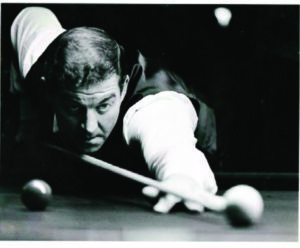
By this time general interest in the game of billiards had waned in Australia. However, this was more than compensated for by the rise of interest in the game of snooker and the American-derived game of pool (eight ball). Snooker assumed great prominence in Australia with the advent of the BBC television series, Pot Black, and the presence of an Australian Player of World stature in Eddie Charlton.
1970 and beyond
From the 1970s, Alcocks became involved once more in sponsorship and/or assistance with amateur and professional tournaments including national and some international events.The Company also provided support for a variety of junior snooker and pool championships.
During the late 1980s interest in the games of snooker and pool intensified further which led to the opening of snooker and pool centres of a more modern style in several of the larger Australian cities, such as Princes Entertainment Centre.
Alcocks provided tables for a number of these centres. In turn, this trend led to more competition and more popular interest in these games. Such competition led to the emergence of some players in Billiards and Snooker of outstanding ability, notably:
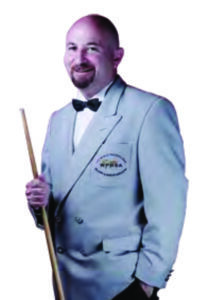
Robby Foldvari, three times World Professional Billiards Champion
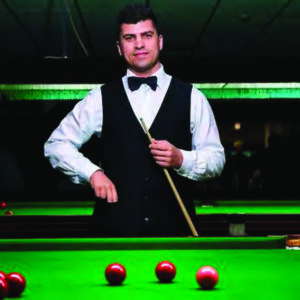
Steve Mifsud, International Billiards and Snooker Federation World Snooker Champion
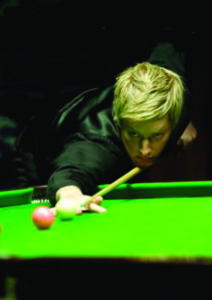
Neil Robertson, Australia’s first World Professional Snooker Champion, and later World No. 1 ranked Snooker player. (For the welcome home for this outstanding champion, click here for video).
It also led to an aspiration of many Australians to enjoy a Billiard Table at home, one which is still prominent today.
Heiron & Smith Billiards
During 1988 Alcocks joined forces with the highly respected New South Wales company, Heiron & Smith Billiards, founded in Sydney in 1883. This enabled Alcocks to develop one centralised manufacturing system to provide tables of the highest quality for both companies.The first joint operation of the two companies was preparation of Tables for the 1988 IBSF World Snooker Championship.
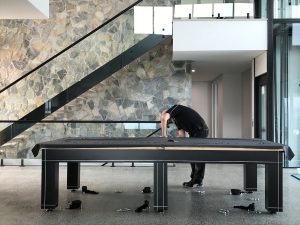
Today Alcocks and Heiron & Smith continue to provide or prepare tables for major Championships, including the Australian National Snooker Championship and the 2019 World Billiards Championship.
And we continue to install tables in the homes of many Australian enthusiasts. Above all, we continue the tradition of excellence which originally made Henry Alcock’s and Walter Heiron’s businesses so well regarded.
Footnotes
- The World of Billiards, September 1901↑
- K Dunstan, Sports, Cassell Australia, 1973↑
- A Ricketts, Walter Lindrum Billiards Phenomenon, Clouston, 1982↑
- H U Alcock, Billiards, 4th edition, Robertson, 1877↑
- C V Jonas, Life of Henry Upton Alcock↑
- H U Alcock, Diary, 1854↑
- The Age, newspaper, 27 August 1862↑
- The Age, newspaper, 10 July 1885↑
- The Argus, newspaper, 28 January 1868↑
- The Argus, newspaper, 25 March 1865↑
- The Argus, newspaper, 29 March 1865↑
- The Argus, newspaper, 2 October 1867↑
- Wikipedia Royal visits to Australia 1867,1881↑
- The Herald, newspaper, 9 July 1885↑
